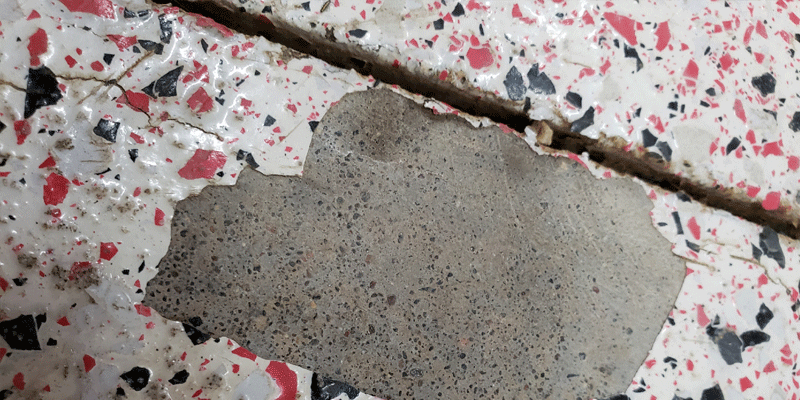Epoxy Floor from Peeling
Table of Contents
If you’re wondering how to prevent epoxy floors from peeling, there are a number of things you can do. If the floor is discolored or appears wet, the problem is probably not with the material itself but rather with how it was applied. Poor application, an unreliable applicator, or the wrong product might all lead to this problem. Luckily, there are many ways to keep an epoxy floor looking its best for years to come.
Discoloration
To determine whether your floor is experiencing a peeling problem, you can look at it visually. If you notice a noticeable color change, the problem likely is not a peeling floor but an irregularly colored one. If you notice discoloration, try scraping off a small top layer section with a sharp knife. There are several ways to fix discoloration on an epoxy floor, including using steam or bleach or hiring a professional to recoat the floor.
First, check for dust. If the surface is dry and crumbly, dust may have gotten under the epoxy. This means the surface has not been properly prepared. You should consider using a floor primer to help consolidate the crumbling concrete. It will also enable the garage floor paint to adhere properly. It is also important to make sure that you use sound surfaces before applying an epoxy floor primer. Make sure to follow the manufacturer’s instructions for the primer application.
Second, check for proper installation. If a floor is misapplied, it may peel off. Another common reason for peeling epoxy is moisture. The floor may be installed correctly, but moisture can cause it to lose its bond with the surface. A poor installation process can result in an unsightly mess and damage to vehicles and forklifts. To prevent the peeling of an epoxy floor, it is necessary to follow the manufacturer’s recommendations for proper installation.
Third, check the thickness of the floor. A good thickness is 3mm. However, the thickness of an epoxy floor depends on the type of floor material underneath it. If the layer is too thin, it will peel and chip. When applying an epoxy floor, it is important to use good adhesives to avoid cracking. To prevent the problem, make sure you use high-grade epoxy floor paint. There are several ways to prevent peeling and chipping, but the main problem is improper application.
A third way to fix discoloration is to refinish the entire floor. A three-inch scraper is useful for this task. Then, use a masonry wheel to grind the edges. Next, apply a clear sealant. Clear sealants are comparable to epoxy paint and can be tested for consistency. If discoloration is still visible, your professional will likely suggest micro-topping or a similar process.
Wet Concrete
One of the most common problems with an epoxy floor is wet concrete. This problem can be prevented by following a few simple steps. First, clean your concrete with a pressure washer. Then, use a concrete cleaner to remove grease and oil spills. Once you’ve cleaned your concrete, let it dry completely before applying your epoxy coat. You can also use a degreaser, which is available on Amazon.
A thin sealant layer on your concrete may prevent your epoxy from bonding with it. This can also cause the coating to flake and bubble. Pouring water on the concrete can help you identify whether or not it has a sealant. If you see a layer of sealant, you should remove it. It is also necessary to give the new concrete enough time to cure. The epoxy coat will stick better to a wet surface if the concrete is slightly rough.
The application of an epoxy garage floor coating requires extensive preparation and cure time. You should allow several days for the first coat to dry completely before applying the second. The darker shades of epoxy contain more hardeners, which can cause a strong ammonia smell after it dries. In addition, darker shades of epoxy tend to be more expensive and have a more slick appearance. To avoid the epoxied garage floor look, consider using a penetrating concrete sealer.
Another reason why your epoxy floor peels are that the floor surface is not prepared properly. Excessive humidity and temperature changes can also inhibit the proper hardening process of the epoxy. This can cause uneven hardening and peeling of the finish. If this happens, it may be time to contact an epoxy coating expert.
Poor Application
One of the most common causes of a peeling epoxy floor is improper application. While proper mix ratio is the key to an epoxy floor, some applications can result in uneven surfaces. One way to spot peeling is to tap the area with a hammer. A hollow sound indicates that there’s a lack of adhesion. Another way to detect peeling is by inspecting for visual disturbances. A careless or inexperienced applicator can leave streaks, dry edges, or noticeable roller marks.
Proper prep and testing are key factors in avoiding peeling epoxy floors. Insufficient preparation can lead to peeling and blistering, so the right prep is critical to avoid such problems. Poor preparation also makes the coating very difficult to remove after it has been cured. As with any type of flooring, a professional should ensure that the surface is dry before the application. A moisture meter must determine the proper moisture content in a concrete floor.
Professionally applied epoxy floors last for years. Professional applicators know how to mix the proper ratio of resin and hardener, which prevents air entrapment, voids, and lumps. They also have advanced application techniques that leave the floor streak-free. For a professional, look no further than Alpine Painting and Restoration, with over 27 years of experience in the industry. So, contact them today for a quality epoxy floor.
Application Process
Whether it is a commercial or residential space, you want to ensure the long-term durability of your epoxy floor. Peeling epoxy floor coatings are not easy to repair and require complete stripping and reapplication. The most common problem is bubble formation. These pinhead-sized bubbles form clusters, called honeycombs, and can be caused by a number of reasons, including incorrect resin-hardener ratio. If you suspect the applicator has applied the coating improperly, you can follow these simple steps to protect your new flooring.
If you notice a white, powdery substance stuck to the back of the coating, it is likely the applicator was not thorough or a mistake was made during the application. If the coating is sticking to the concrete, this indicates poor quality of the concrete and is caused by poor preparation. Fortunately, the coating will be far more durable than the concrete. If this is the case, you should have your floor ground and pressure washed to remove any residue.
Overworking the concrete is another common problem. It causes the aggregate to show through the top layer of the finished product. Besides improper mixing, the improper application technique can result in uneven sheens and streaks on the floor. Additionally, an improper application can lead to inconsistent application rates, a lack of uniformity, and noticeable roller marks. Fortunately, you can prevent this problem by hiring an experienced applicator who follows these guidelines.
To avoid the peeling of epoxy floors, hire a professional. These professionals understand the proper mixing ratio between the hardener and the resin. They also anticipate temperature and humidity conditions to avoid developing lumps and air bubbles. They will also avoid leaving a floor with a tacky or dull finish.
If you are wondering how to prevent the peeling and cracking of epoxy flooring, you should hire our team of locally-based experts. We have years of experience and have the knowledge and expertise needed to help you achieve a beautiful floor.

